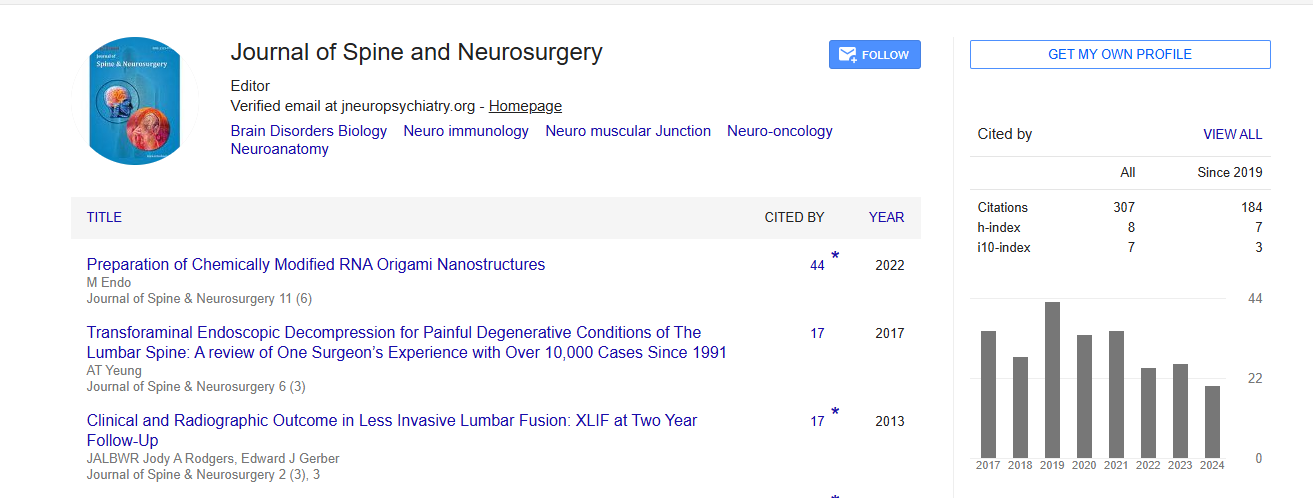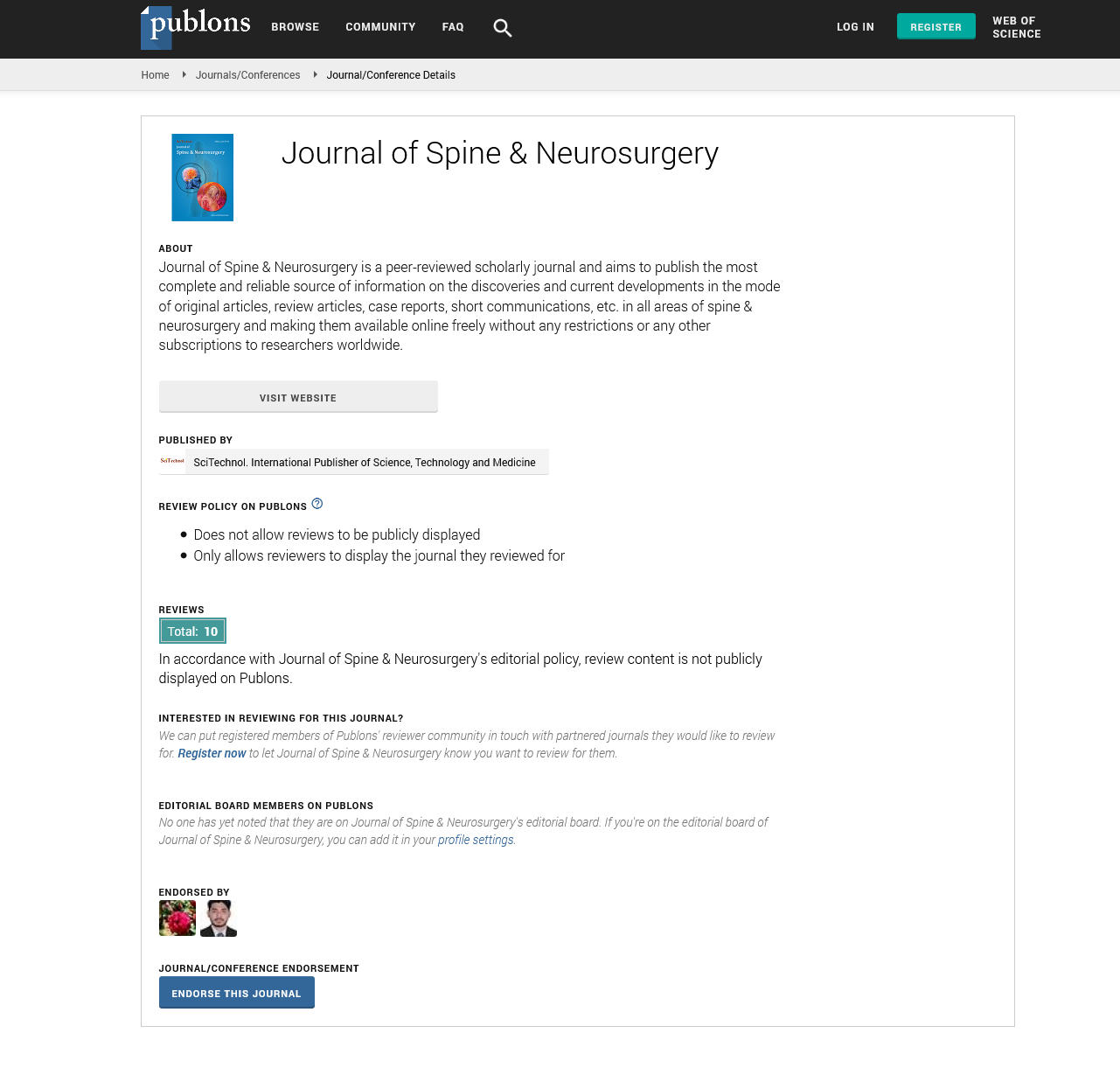Commentary, J Spine Neurosurg Vol: 12 Issue: 6
Complexities of Epilepsy a Chronic Neurological Disorder
Xiaun Xia*
1Department of Neurology, Guangzhou Medical University, Guangzhou, China
*Corresponding Author: Xiaun Xia,
Department of Neurology, Guangzhou
Medical University, Guangzhou, China
E-mail: xiaun_xia10@gmail.com
Received date: 27 November, 2023, Manuscript No. JSNS-24-128384;
Editor assigned date: 29 November, 2023, PreQC No. JSNS-24-128384 (PQ);
Reviewed date: 14 December, 2023, QC No. JSNS-24-128384;
Revised date: 21 December, 2023, Manuscript No. JSNS-24-128384 (R);
Published date: 28 December, 2023, DOI: 10.4172/2325-9701.1000183.
Citation: Xia X (2023) Complexities of Epilepsy a Chronic Neurological Disorder. J Spine Neurosurg 12:6.
Description
Epilepsy is a neurological disorder that has fascinated and medical professionals and researchers throughout history. Characterized by recurrent seizures, epilepsy manifests in various forms and affects individuals of all ages. This aims to unravel the complexities of epilepsy, exploring its definition, types of seizures, causes, diagnosis, and management, the challenges faced by those living with this condition. Epilepsy is a chronic neurological disorder characterized by the occurrence of recurrent seizures. A seizure is a sudden surge of electrical activity in the brain that can result in various symptoms, ranging from brief lapses in consciousness to convulsions. Epileptic seizures can manifest in diverse ways, and the symptoms experienced depend on the area of the brain affected. Some seizures may involve subtle sensations or moments of confusion, while others may lead to dramatic conculsions.
Types of seizures
Generalized seizures affect both hemispheres of the brain and may cause loss of consciousness. Subtypes include tonic-clonic seizures (formerly known as grand mal), absence seizures (formerly known as petit mal), and myoclonic seizures. Partial seizures originate in a specific area of the brain and may or may not involve altered consciousness. Simple partial seizures cause localized symptoms, while complex partial seizures may lead to altered awareness and unusual behaviors. In many cases, the cause of epilepsy remains unknown, and it is referred to as idiopathic epilepsy. Genetic factors may play a role in predisposing individuals to the condition.
Brain injuries, tumors, strokes, or developmental disorders can lead to structural abnormalities that may trigger epilepsy. Infections such as meningitis or encephalitis and certain neurological conditions, including Alzheimer's disease, may increase the risk of developing epilepsy. Some forms of epilepsy have a genetic basis, and certain gene mutations may contribute to an increased susceptibility to seizures.
Diagnosis typically involves a thorough clinical evaluation, including a detailed medical history, description of seizure episodes, and assessment of potential triggers. Electroencephalogram (EEG) measures electrical activity in the brain and is a vital diagnostic tool for identifying abnormal patterns associated with epilepsy. Brain imaging techniques, such as MRI or CT scans, may be employed to identify structural abnormalities or lesions that could be causing seizures. Blood tests may be conducted to rule out metabolic or genetic factors that could contribute to epilepsy.
Management and treatment
The primary treatment for epilepsy involves antiepileptic medications, which aim to control or reduce the frequency of seizures. The choice of medication depends on the type of seizures and individual response. Individuals with epilepsy are often advised to adopt lifestyle modifications, such as getting adequate sleep, managing stress, and avoiding potential triggers like certain foods or substances. In some cases, a ketogenic diet, which is high in fats and low in carbohydrates, may be recommended for individuals with epilepsy, particularly when medications are not fully effective. For individuals with severe and medication-resistant epilepsy, surgical interventions, such as brain surgery or the implantation of devices like vagus nerve stimulators, may be considered. Living with epilepsy can impact an individual's psychosocial well-being. Support groups, counseling, and educational resources can provide valuable assistance in coping with the challenges associated with epilepsy.
Despite advances in understanding and treatment, epilepsy continues to face social humiliation and misconceptions. Education and awareness campaigns are important in dispelling myths surrounding the condition. Epilepsy can significantly impact an individual's daily life, affecting employment, education, and social interactions. Supportive environments and understanding from the community are essential in overcoming these challenges.
Conclusion
Epilepsy, a multifaceted neurological disorder, highlights the intricate interplay between genetics, brain function, and environmental factors. While the path to effective management may involve challenges, advancements in medical understanding and treatment options offer hope for improved outcomes. Empowering individuals with epilepsy through awareness, support, and access to comprehensive care is essential in fostering a society that embraces and accommodates those living with this condition.
 Spanish
Spanish  Chinese
Chinese  Russian
Russian  German
German  French
French  Japanese
Japanese  Portuguese
Portuguese  Hindi
Hindi 
